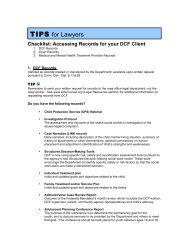Making Court the Last Resort - Center for Children's Advocacy
Making Court the Last Resort - Center for Children's Advocacy
Making Court the Last Resort - Center for Children's Advocacy
You also want an ePaper? Increase the reach of your titles
YUMPU automatically turns print PDFs into web optimized ePapers that Google loves.
The FINS/CINS model that Florida developed demonstrates that youth at risk ofentering <strong>the</strong> status offender system can thrive when provided immediate, tailored crisisintervention. “We’ve been working long and hard to offer responsive services to youthand families in crisis,” says Mary Dee Richter, executive director of <strong>the</strong> Network.“By helping families stay toge<strong>the</strong>r, we are saving taxpayer dollars and streng<strong>the</strong>ningties between families and <strong>the</strong>ir home communities. Just as important, we are servinghabitually truant youth and stemming <strong>the</strong> flow of youth into <strong>the</strong> juvenile justice system.”Local Partnerships, Statewide ImpactPINS Re<strong>for</strong>m in New YorkThe status offender system in Orange County, New York—about a one-hour drivenorth of New York City—has seen many changes in <strong>the</strong> past five years. Be<strong>for</strong>e 2003,parents seeking assistance <strong>for</strong> a child who was skipping school, running away, oro<strong>the</strong>rwise acting out would contact <strong>the</strong> Orange County Probation Department. Probationofficers would <strong>the</strong>n conduct an intake and assessment and develop a service plan.Typically, families could wait as long as two months to be linked to helpful services.During this time, <strong>the</strong> crises that led <strong>the</strong>m to seek help in <strong>the</strong> first place often escalated.Referrals to family court were common, and many youth were removed from <strong>the</strong>ir homes.Outcomes from this approach were both grim and costly.Resolving to do better, leaders in Orange County came toge<strong>the</strong>r to change <strong>the</strong>county’s strategy <strong>for</strong> serving status offenders, who in New York State are referred toas Persons in Need of Supervision (PINS). 5 As in Florida, Orange County’s new modelwas based on evidence suggesting that families in crisis respond best when <strong>the</strong>y ge<strong>the</strong>lp quickly and do not rely on <strong>the</strong> family court <strong>for</strong> support. An interdisciplinary groupof stakeholders comprising representatives from juvenile justice, social services, mentalhealth organizations, and nonprofit agencies began a planning process to realize this goal.Orange County’s collaborative planning process culminated in 2003 in <strong>the</strong> launchof <strong>the</strong> Family Keys program. Family Keys, a part of Southwest Key Programs, is acommunity-based, nonprofit organization that aims to decrease <strong>the</strong> number of PINS casesthat go to court and <strong>the</strong> number of PINS youth placed in out-of-home care. 6 Under <strong>the</strong>new system, parents seeking help <strong>for</strong> a chronically misbehaving child still contact <strong>the</strong>probation department. After an initial screening by a probation officer, eligible familiesare now referred—immediately—to Family Keys. 7 Family Keys sends a case worker tovisit and interview <strong>the</strong> family within 48 hours of referral. In severe cases, a case workermay be dispatched within two hours. After conducting an assessment, <strong>the</strong> case worker6 <strong>Making</strong> <strong>Court</strong> <strong>the</strong> <strong>Last</strong> <strong>Resort</strong>: A New Focus <strong>for</strong> Supporting Families in Crisis
















